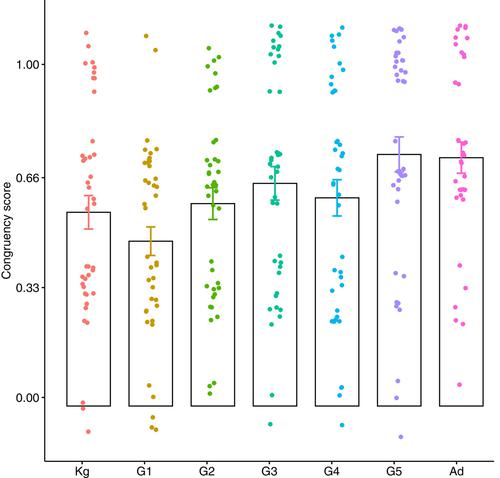当前位置:
X-MOL 学术
›
Ann. N. Y. Acad. Sci.
›
论文详情
Our official English website, www.x-mol.net, welcomes your feedback! (Note: you will need to create a separate account there.)
The development of working memory spatialization revealed by using the cave paradigm in a two‐alternative spatial choice
Annals of the New York Academy of Sciences ( IF 5.2 ) Pub Date : 2020-07-26 , DOI: 10.1111/nyas.14433 Alessandro Guida 1 , Michaël Fartoukh 2 , Fabien Mathy 2
Annals of the New York Academy of Sciences ( IF 5.2 ) Pub Date : 2020-07-26 , DOI: 10.1111/nyas.14433 Alessandro Guida 1 , Michaël Fartoukh 2 , Fabien Mathy 2
Affiliation

|
When Western participants are asked to keep in mind a sequence of verbal items, they tend to associate the first items to the left and the last items to the right. This phenomenon, known as the spatial–positional association response codes effect, has been interpreted as showing that individuals spatialize the memoranda by creating a left‐to‐right mental line with them. One important gap in our knowledge concerns the development of this phenomenon: when do Western individuals start organizing their thought from left to right? To answer this question, 274 participants in seven age groups were tested (kindergarten, Grades 1, 2, 3, 4, and 5, and adults). We used a new protocol meant to be child‐friendly, which involves associating two caves with two animals using a two‐alternative spatial forced choice. Participants had to guess in which cave a specific animal could be hidden. Results showed that it is from Grade 3 on that participants spatialize information in working memory in a left‐to‐right fashion like adults.
中文翻译:

在双重空间选择中使用洞穴范式揭示工作记忆空间化的发展
当西方参与者被要求记住一系列口头项目时,他们倾向于将第一个项目与左侧相关联,将最后一个项目与右侧相关联。这种被称为空间位置关联反应代码效应的现象被解释为表明个人通过与他们创建从左到右的心理线来空间化备忘录。我们知识中的一个重要空白与这一现象的发展有关:西方人什么时候开始从左到右组织他们的思想?为了回答这个问题,测试了七个年龄组(幼儿园、1、2、3、4 和 5 年级以及成人)的 274 名参与者。我们使用了一种旨在对儿童友好的新协议,其中涉及使用两种替代空间强制选择将两个洞穴与两种动物相关联。参与者必须猜测特定动物可以隐藏在哪个洞穴中。结果表明,从三年级开始,参与者像成年人一样以从左到右的方式空间化工作记忆中的信息。
更新日期:2020-07-26
中文翻译:

在双重空间选择中使用洞穴范式揭示工作记忆空间化的发展
当西方参与者被要求记住一系列口头项目时,他们倾向于将第一个项目与左侧相关联,将最后一个项目与右侧相关联。这种被称为空间位置关联反应代码效应的现象被解释为表明个人通过与他们创建从左到右的心理线来空间化备忘录。我们知识中的一个重要空白与这一现象的发展有关:西方人什么时候开始从左到右组织他们的思想?为了回答这个问题,测试了七个年龄组(幼儿园、1、2、3、4 和 5 年级以及成人)的 274 名参与者。我们使用了一种旨在对儿童友好的新协议,其中涉及使用两种替代空间强制选择将两个洞穴与两种动物相关联。参与者必须猜测特定动物可以隐藏在哪个洞穴中。结果表明,从三年级开始,参与者像成年人一样以从左到右的方式空间化工作记忆中的信息。



























 京公网安备 11010802027423号
京公网安备 11010802027423号